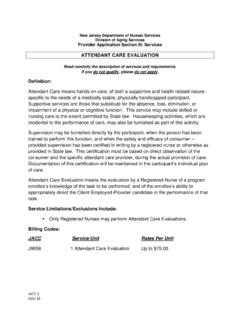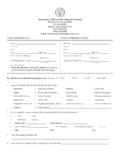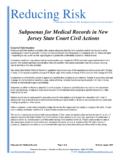Transcription of 1 of 7 DOCUMENTS - New Jersey
1 Page 1 1 of 7 documents NEW Jersey REGISTER Copyright 2007 by the New Jersey Office of Administrative Law VOLUME 39, ISSUE 4 ISSUE DATE: FEBRUARY 20, 2007 RULE PROPOSALS LAW AND PUBLIC SAFETY OFFICE OF THE ATTORNEY GENERAL DIVISION OF STATE POLICE 39 606(a) Proposed New Rules: 13:81 DNA Database And Databank Rules Authorized By: Stuart Rabner, Attorney General of New Jersey , and Colonel Joseph R. Fuentes, Superintendent, Divi sion of State Police. Authority: 53:1 et seq. Calendar Reference: See Summary below for explanation of exception to calendar requirements. Proposal Number: PRN 2007 51. Submit written comments by April 21, 2007 to: Patricia Prezioso, Assistant Attorney General Deputy Director, Division of Criminal Justice 25 Market Street Box 085 Trenton, New Jersey 08625 0085 The agency proposal follows: Summary These rules establish methods and standards to administer the DNA Database and Databank Act of 1994 ("DNA Act" or "Act"), 53:1 et seq.
2 , as it relates to the submission, identification, storage and analysis of DNA samples the methods of obtaining information from the State database and CODIS (Combined DNA Index System) and the procedures for verification of the identity and authority of the requester. These rules also include quality assur ance guidelines. In enacting 53:1 et seq., the Legislature has determined that DNA sampling and DNA databases are important tools in criminal investigations and in deterring and detecting recidivist acts. Moreover, the Legislature has declared that it is the policy of New Jersey to assist Federal, state and local criminal justice and law enforcement agen cies in the identification and detection of individuals in criminal investigations. The Legislature has concluded that it is therefore in the best interest of New Jersey to establish a DNA databank containing DNA samples and a DNA database containing DNA profiles of, among others, individuals convicted of crimes, juveniles adjudicated delinquent for acts Page 2 39 606(a) which, if committed by an adult, would constitute a crime, and individuals found not guilty by reason of insanity of a crime.
3 DNA analysis is a powerful tool because each person's DNA is unique (with the exception of identical twins). Therefore, DNA collected from a crime scene can implicate or eliminate a suspect, similar to, but technologically supe rior to, the use of fingerprint analysis. Pursuant to the requirements of the DNA Act, the DNA profile of identification characteristics resulting from DNA testing is stored and maintained in the State DNA database and also forwarded to the Federal Bureau of Investigation for inclusion in CODIS, the FBI's national DNA identification index system that allows the storage and exchange of DNA profiles submitted by state and local forensic laboratories. The New Jersey DNA database is combined with other state databases by the FBI into its CODIS system.
4 This enables various states to share their databases and provides a means to search for criminal suspects regionally and nationally. The DNA sample itself is stored and maintained in the State DNA databank. The DNA Act imposes strict confidentiality requirements and privacy protections, has safeguards against improper disclosure, and takes significant measures to protect offenders from whom DNA samples are taken. The Act provides that all DNA profiles and samples of offenders shall be treated as confidential except insofar as disclosure is authorized under the Act. The Act permits expungement of the DNA sample from the databank and profile from the database if the charges that resulted in inclusion have been reversed and dismissed. The Act imposes disorderly person penalties upon any person who makes an unauthorized disclosure.
5 The Act prohibits the taking of redundant samples if, upon a prior occasion, the person supplied a sample that was adequate for successful analysis and identification. Although the Act initially required blood samples, improvements in DNA technology persuaded the Legislature to amend the Act in 2000 to allow the taking of less intrusive biological samples, such as those procured by the buccal swab. The routine method of sample collection in New Jersey is by buccal swabbing. A buccal swab is a specialized applicator with a sponge or foam tip, which is rubbed on the inside of the cheek to collect epithelial cells. This proce dure is noninvasive and pain free. In non routine circumstances, for example, when a DNA sample must be obtained by force, a blood sample would be obtained while the offender is restrained.
6 When it is necessary to take a blood sample by force, the practice is to acquire a court order. Additionally, the Department of Health and Senior Services, which super vises those found not guilty by reason of insanity, may elect to take a blood sample rather than a buccal swab sample. Whether blood, swab, or other biological material, the sample must be taken only by appropriate professionals or spe cially trained personnel. From its inception the DNA Act has provided that no person shall be relieved from liability for negligence in the drawing or collecting of any DNA sample. The DNA Act provides that the results of DNA testing of offenders may be used for law enforcement identification purposes, to assist in the recovery or identification of human remains from mass disasters or for other humanitarian pur poses, and for judicial proceedings, by order of the court.
7 The DNA Act also provides that the results of DNA testing of offenders may be used for criminal defense purposes, on behalf of a defendant, who shall have access to relevant sam ples and analyses performed in connection with the case in which the defendant is charged. The DNA Act initially required only persons convicted of certain sex offenses to provide a blood sample for DNA profiling. In 1997, the Act was expanded to require a blood sample from juveniles adjudicated delinquent for acts which, if committed by an adult, would constitute one of these sex offenses and to require as well blood samples from defendants and juveniles found not guilty by reason of insanity, or adjudicated not delinquent by reason of insanity, of one of these sex offenses. In 2000, the Act was amended again, and the amendment considerably expanded the list of covered crimes and also provided that biological samples other than blood could be utilized for DNA sampling.
8 Following the lead of several other states, New Jersey amended its DNA Act again in 2003 to broaden the catego ries of persons from whom DNA samples must be taken (enacted on September 22, 2003, to take effect immediately). Whereas, prior to the amendment, DNA samples were taken only for certain crimes, the amendment requires DNA samples of all adult and juvenile offenders who have been convicted or found not guilty by reason of insanity of any crime (or, in the case of the juvenile, for an act which, if committed by an adult, would constitute any crime). 53:1 (g) 53:1 (h). The amendment also requires DNA sampling of convicted adults and delinquent juveniles whose crimes and criminally delinquent acts preceded the enactment date (September 22, 2003) if, on that date, they were serving a sentence of imprisonment, detention, confinement, probation, parole, or other form of supervi sion.
9 53:1 (g) and (h) (as amended by 2003, c. 183, 3). Recidivism is a serious problem and the State's interest in detecting and deterring it is compelling. DNA collection deters convicted offenders from committing new crimes by making them aware that the government has identification information that can incriminate them in the event that they commit a crime. In this way, the deterrent value of the DNA. Page 3 39 606(a) sample contributes to the convicted offender's rehabilitation. Moreover, in the event that deterrence fails and the of fender does commit a new crime, DNA sampling increases the likelihood that he or she will be apprehended promptly, before he or she can commit more offenses. In addition to deterring recidivism, DNA collection also deters persons not convicted of crimes but otherwise tempted to make their living by criminal enterprise because of their realization that a single conviction will provide an identifier that may connect them with pre conviction criminal conduct.
10 The State's interest in exonerating the innocent is also compelling. DNA collection significantly advances this in terest. As of 2005, at least 143 people had been exonerated by DNA evidence, 13 of whom were sentenced to death. Both in the investigative stage of criminal cases, and in the post conviction setting, DNA testing may exonerate an indi vidual who is mistakenly suspected or convicted of committing a crime by identifying the actual perpetrator. Thus, the full value of DNA exoneration cannot be attained without a convicted offender database that allows DNA comparison with a large group of offenders among whom the actual culprit is more likely to be found. The DNA Database and Databank maintained by the New Jersey State Police, Office of Forensic Sciences resides in the New Jersey State Police Forensic Science Technology Center.















![firearms qualifications [PFP#841090829] - New Jersey](/cache/preview/5/b/8/2/6/8/d/1/thumb-5b8268d1a3bec7c73b5daae09ec8f056.jpg)
